KIA Spectra 2006 2.G Owner's Manual
Manufacturer: KIA, Model Year: 2006, Model line: Spectra, Model: KIA Spectra 2006 2.GPages: 273, PDF Size: 2.83 MB
Page 241 of 273

719
Maintenance
1
2
3
4
5
6
7
8
9
STEERING WHEELPark the vehicle on level ground,
start the car and place the tire
wheels in the straight-ahead posi-
tion. Turn the steering wheel to the
left and right with a little force and
check the free play until you get a
feel for resistance against the tire
wheels movement.
Standard value: 30 mm (1.2 in) or
less
✽ ✽NOTICEIf the measured value exceeds the
standard value, have the system
checked by an authorized Kia deal-
er.
1LDN501930 mm
(1.2 in)
LD CAN (ENG) 7.qxd 7/29/05 10:23 AM Page 19
Page 242 of 273

Maintenance20
7AUTOMATIC TRANSAXLE (IF EQUIPPED)Checking the automatic
transaxle fluid level The automatic transaxle fluid level
should be checked regularly.
The volume of the transaxle fluid
changes with temperature. Although
it is best to check the level after hav-
ing driven the vehicle for at least 30
minutes, the level can be checked
after warming the fluid using the fol-
lowing procedure. 1. Park the vehicle on level ground
and firmly apply the parking brake.
2. Allow the engine to idle for about 2 minutes.
3. Depress the brake pedal and move the shift lever slowly through
all ranges then set it in P (Park).
4. With the engine still idling, pull out the dipstick, wipe it clean and rein-
sert it fully.
5. Pull out the dipstick again and check the fluid level.
1
2
3
4
5
6
7
8
9
CAUTION
• Low fluid level causestransaxle slippage. Overfilling
can cause foaming, loss of
fluid and transaxle malfunc-
tion.
The use of a non-specified fluid could result in transaxle
malfunction and failure.
WARNING
- Parking brake
To avoid sudden movement of
the vehicle, apply parking brake
and depress the brake pedal
before moving the shift lever.
1LDA5008
LD CAN (ENG) 7.qxd 7/29/05 10:23 AM Page 20
Page 243 of 273
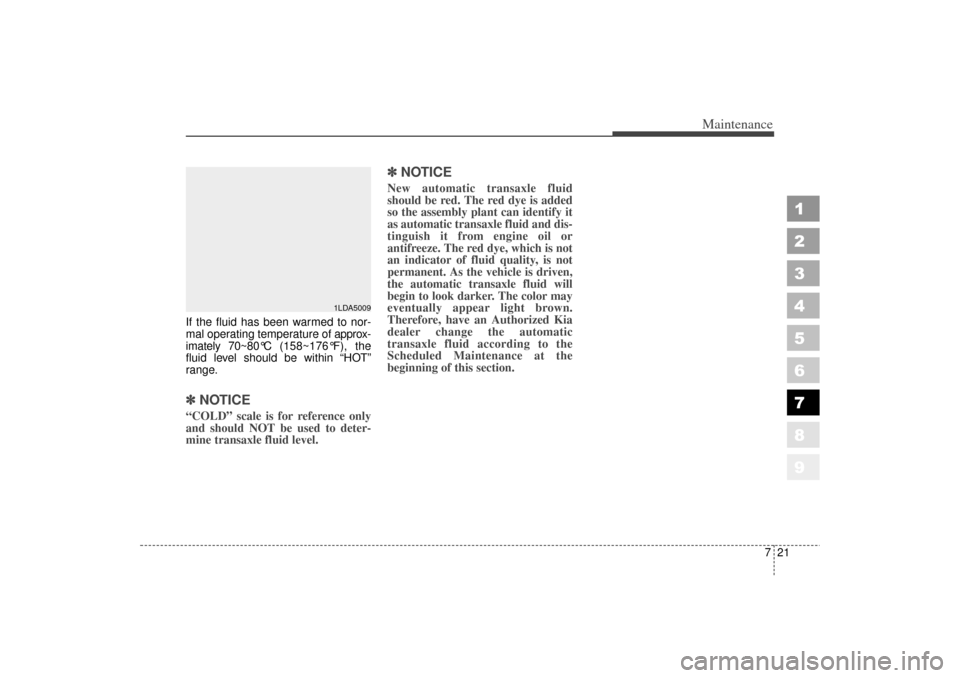
721
Maintenance
1
2
3
4
5
6
7
8
9
If the fluid has been warmed to nor-
mal operating temperature of approx-
imately 70~80°C (158~176°F), the
fluid level should be within “HOT”
range.✽ ✽ NOTICE“COLD” scale is for reference only
and should NOT be used to deter-
mine transaxle fluid level.
✽ ✽NOTICENew automatic transaxle fluid
should be red. The red dye is added
so the assembly plant can identify it
as automatic transaxle fluid and dis-
tinguish it from engine oil or
antifreeze. The red dye, which is not
an indicator of fluid quality, is not
permanent. As the vehicle is driven,
the automatic transaxle fluid will
begin to look darker. The color may
eventually appear light brown.
Therefore, have an Authorized Kia
dealer change the automatic
transaxle fluid according to the
Scheduled Maintenance at the
beginning of this section.
1LDA5009
LD CAN (ENG) 7.qxd 7/29/05 10:23 AM Page 21
Page 244 of 273
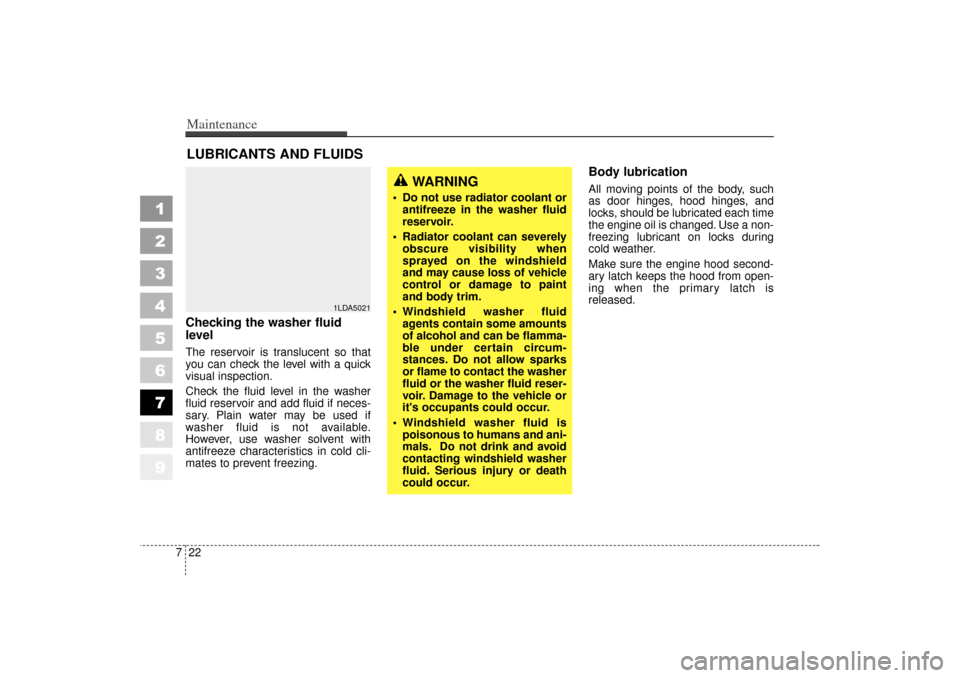
Maintenance22
7
1
2
3
4
5
6
7
8
9
LUBRICANTS AND FLUIDS Checking the washer fluid
level The reservoir is translucent so that
you can check the level with a quick
visual inspection.
Check the fluid level in the washer
fluid reservoir and add fluid if neces-
sary. Plain water may be used if
washer fluid is not available.
However, use washer solvent with
antifreeze characteristics in cold cli-
mates to prevent freezing.
Body lubrication All moving points of the body, such
as door hinges, hood hinges, and
locks, should be lubricated each time
the engine oil is changed. Use a non-
freezing lubricant on locks during
cold weather.
Make sure the engine hood second-
ary latch keeps the hood from open-
ing when the primary latch is
released.
1LDA5021
WARNING
Do not use radiator coolant or
antifreeze in the washer fluid
reservoir.
Radiator coolant can severely obscure visibility when
sprayed on the windshield
and may cause loss of vehicle
control or damage to paint
and body trim.
Windshield washer fluid agents contain some amounts
of alcohol and can be flamma-
ble under certain circum-
stances. Do not allow sparks
or flame to contact the washer
fluid or the washer fluid reser-
voir. Damage to the vehicle or
it's occupants could occur.
Windshield washer fluid is poisonous to humans and ani-
mals. Do not drink and avoid
contacting windshield washer
fluid. Serious injury or death
could occur.
LD CAN (ENG) 7.qxd 7/29/05 10:23 AM Page 22
Page 245 of 273
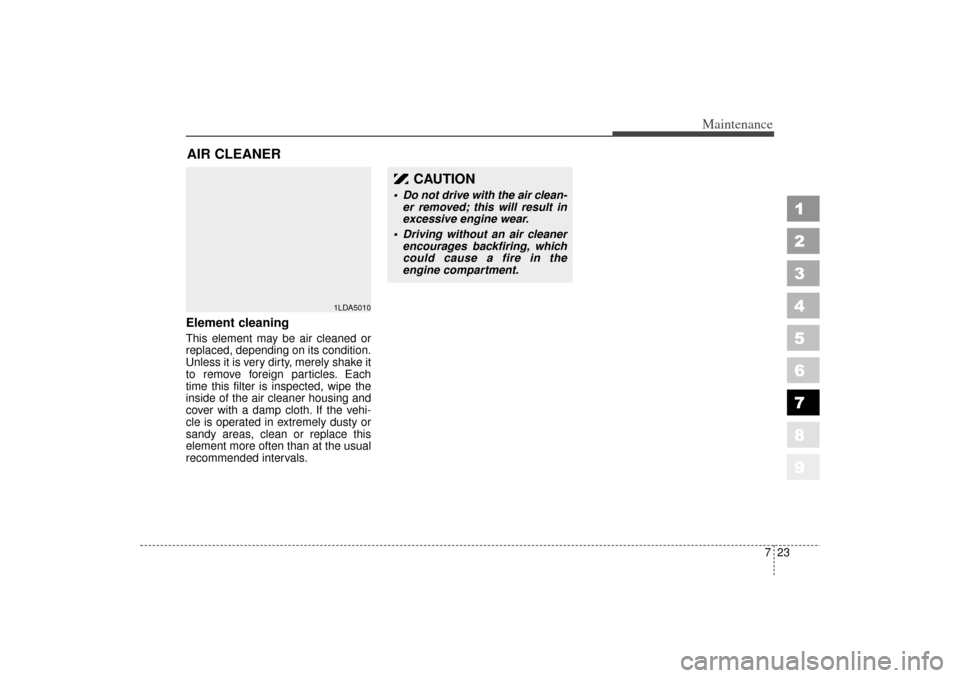
723
Maintenance
1
2
3
4
5
6
7
8
9
AIR CLEANER Element cleaningThis element may be air cleaned or
replaced, depending on its condition.
Unless it is very dirty, merely shake it
to remove foreign particles. Each
time this filter is inspected, wipe the
inside of the air cleaner housing and
cover with a damp cloth. If the vehi-
cle is operated in extremely dusty or
sandy areas, clean or replace this
element more often than at the usual
recommended intervals.
1LDA5010
CAUTION
Do not drive with the air clean-er removed; this will result in
excessive engine wear.
Driving without an air cleaner encourages backfiring, which
could cause a fire in the
engine compartment.
LD CAN (ENG) 7.qxd 7/29/05 10:23 AM Page 23
Page 246 of 273
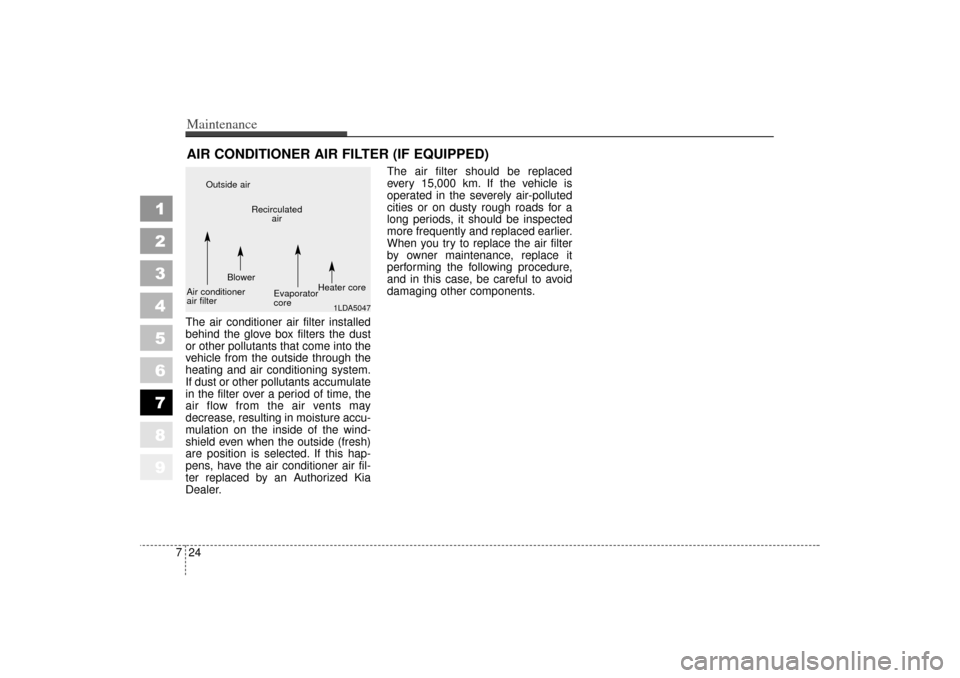
Maintenance24
7
1
2
3
4
5
6
7
8
9
AIR CONDITIONER AIR FILTER (IF EQUIPPED)The air conditioner air filter installed
behind the glove box filters the dust
or other pollutants that come into the
vehicle from the outside through the
heating and air conditioning system.
If dust or other pollutants accumulate
in the filter over a period of time, the
air flow from the air vents may
decrease, resulting in moisture accu-
mulation on the inside of the wind-
shield even when the outside (fresh)
are position is selected. If this hap-
pens, have the air conditioner air fil-
ter replaced by an Authorized Kia
Dealer. The air filter should be replaced
every 15,000 km. If the vehicle is
operated in the severely air-polluted
cities or on dusty rough roads for a
long periods, it should be inspected
more frequently and replaced earlier.
When you try to replace the air filter
by owner maintenance, replace it
performing the following procedure,
and in this case, be careful to avoid
damaging other components.
1LDA5047
Outside air
Recirculatedair
Air conditioner
air filter Blower
Evaporator
coreHeater core
LD CAN (ENG) 7.qxd 7/29/05 10:23 AM Page 24
Page 247 of 273

725
Maintenance
1
2
3
4
5
6
7
8
9
WIPER BLADES Wiper blade maintenance ✽ ✽NOTICECommercial hot waxes applied by
automatic car washes have been
known to make the windshield diffi-
cult to clean.
Contamination of either the wind-
shield or the wiper blades with for-
eign matter can reduce the effective-
ness of the windshield wipers.
Common sources of contamination
are insects, tree sap, and hot wax
treatments used by some commer-
cial car washes. If the blades are not
wiping properly, clean both the win-
dow and the blades with a good
cleaner or mild detergent, and rinse
thoroughly with clean water.✽ ✽NOTICETo prevent damage to the wiper
blades, do not use gasoline,
kerosene, paint thinner, or other sol-
vents on or near them.
Windshield wiper blade
replacement When the wipers no longer clean
adequately, the blades may be worn
or cracked, and require replacement.✽ ✽NOTICETo prevent damage to the wiper
arms or other components, do not
attempt to move the wipers manual-
ly. ✽ ✽NOTICEThe use of a non-specified wiper
blade could result in wiper malfunc-
tion and failure.
1LDA5022
LD CAN (ENG) 7.qxd 7/29/05 10:23 AM Page 25
Page 248 of 273

Maintenance26
7
1
2
3
4
5
6
7
8
9
1. Raise the wiper arm and turn the
wiper blade assembly to expose
the plastic locking clip.✽ ✽NOTICEDo not allow the wiper arm to fall
against the windshield.
2. Compress the clip and slide the
blade assembly downward. 3. Lift it off the arm.
4. Install the blade assembly in the
reverse order of removal.
1LDA5023
1LDA5024
1LDA5025
LD CAN (ENG) 7.qxd 7/29/05 10:23 AM Page 26
Page 249 of 273

727
Maintenance
1
2
3
4
5
6
7
8
9
BATTERY
WARNING
- Battery dangers
Always read the follow-
ing instructions carefully
when handling a battery.
Keep lighted cigarettes and all other flames or
sparks away from the
battery.
Hydrogen, which is a highly combustible gas,
is always present in bat-
tery cells and may
explode if ignited.
Keep batteries out of the reach of children
because batteries con-
tain highly corrosive
SULFURIC ACID. Do not
allow battery acid to con-
tact your skin, eyes,
clothing or paint finish.
(Continued)
(Continued)If any electrolyte getsinto your eyes, flush your
eyes with clean water for
at least 15 minutes and
get immediate medical
attention. If possible,
continue to apply water
with a sponge or cloth
until medical attention is
received.
If electrolyte gets on
your skin, thoroughly
wash the contacted area.
If you feel a pain or a
burning sensation, get
medical attention imme-
diately.
Wear eye protection when charging or work-
ing near a battery.
Always provide ventila-
tion when working in an
enclosed space.
(Continued)
(Continued)
When lifting a plastic-casedbattery, excessive pressure on
the case may cause battery
acid to leak, resulting in per-
sonal injury. Lift with a battery
carrier or with your hands on
opposite corners.
Never attempt to charge the battery when the battery
cables are connected.
The electrical ignition system works with high voltage.
Never touch these compo-
nents with the engine running
or the ignition switched on.
LD CAN (ENG) 7.qxd 7/29/05 10:23 AM Page 27
Page 250 of 273
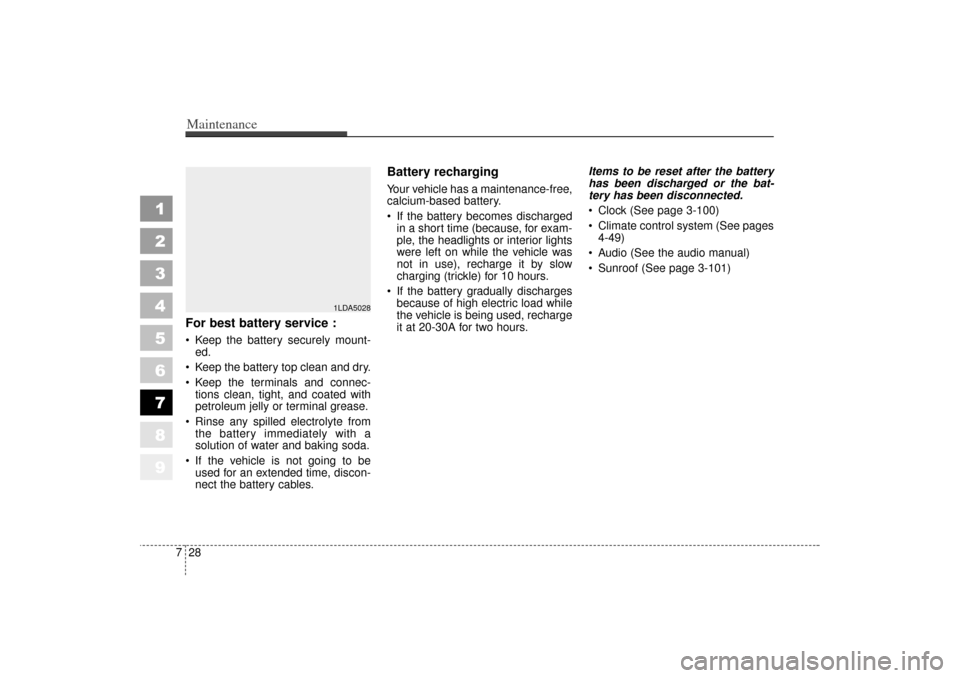
Maintenance28
7
1
2
3
4
5
6
7
8
9
For best battery service : Keep the battery securely mount-
ed.
Keep the battery top clean and dry.
Keep the terminals and connec- tions clean, tight, and coated with
petroleum jelly or terminal grease.
Rinse any spilled electrolyte from the battery immediately with a
solution of water and baking soda.
If the vehicle is not going to be used for an extended time, discon-
nect the battery cables.
Battery recharging Your vehicle has a maintenance-free,
calcium-based battery.
If the battery becomes dischargedin a short time (because, for exam-
ple, the headlights or interior lights
were left on while the vehicle was
not in use), recharge it by slow
charging (trickle) for 10 hours.
If the battery gradually discharges because of high electric load while
the vehicle is being used, recharge
it at 20-30A for two hours. Items to be reset after the battery
has been discharged or the bat-
tery has been disconnected.
Clock (See page 3-100)
Climate control system (See pages
4-49)
Audio (See the audio manual)
Sunroof (See page 3-101)
1LDA5028
LD CAN (ENG) 7.qxd 7/29/05 10:23 AM Page 28